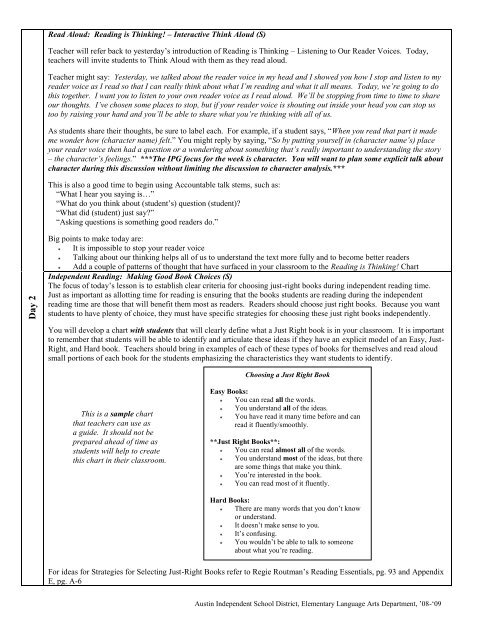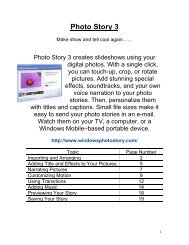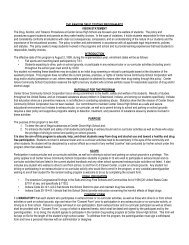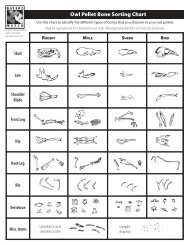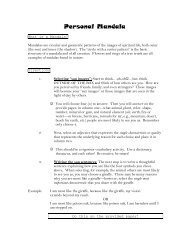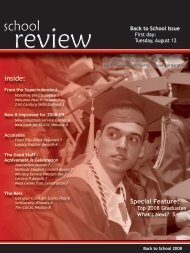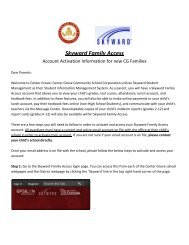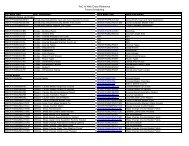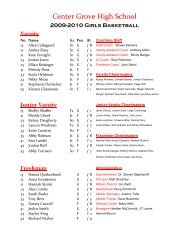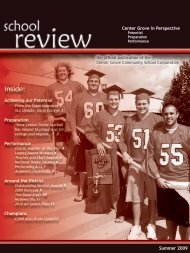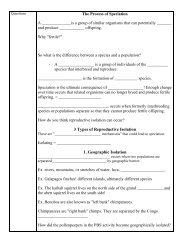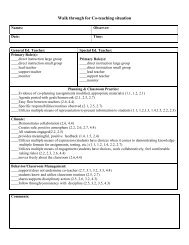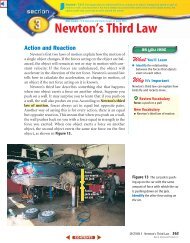The First 20 Days of Reading: Intermediate - Center Grove ...
The First 20 Days of Reading: Intermediate - Center Grove ...
The First 20 Days of Reading: Intermediate - Center Grove ...
You also want an ePaper? Increase the reach of your titles
YUMPU automatically turns print PDFs into web optimized ePapers that Google loves.
Day 2<br />
Read Aloud: <strong>Reading</strong> is Thinking! – Interactive Think Aloud (S)<br />
Teacher will refer back to yesterday‟s introduction <strong>of</strong> <strong>Reading</strong> is Thinking – Listening to Our Reader Voices. Today,<br />
teachers will invite students to Think Aloud with them as they read aloud.<br />
Teacher might say: Yesterday, we talked about the reader voice in my head and I showed you how I stop and listen to my<br />
reader voice as I read so that I can really think about what I’m reading and what it all means. Today, we’re going to do<br />
this together. I want you to listen to your own reader voice as I read aloud. We’ll be stopping from time to time to share<br />
our thoughts. I’ve chosen some places to stop, but if your reader voice is shouting out inside your head you can stop us<br />
too by raising your hand and you’ll be able to share what you’re thinking with all <strong>of</strong> us.<br />
As students share their thoughts, be sure to label each. For example, if a student says, “When you read that part it made<br />
me wonder how (character name) felt.” You might reply by saying, “So by putting yourself in (character name’s) place<br />
your reader voice then had a question or a wondering about something that’s really important to understanding the story<br />
– the character’s feelings.” ***<strong>The</strong> IPG focus for the week is character. You will want to plan some explicit talk about<br />
character during this discussion without limiting the discussion to character analysis.***<br />
This is also a good time to begin using Accountable talk stems, such as:<br />
“What I hear you saying is…”<br />
“What do you think about (student‟s) question (student)<br />
“What did (student) just say”<br />
“Asking questions is something good readers do.”<br />
Big points to make today are:<br />
It is impossible to stop your reader voice<br />
Talking about our thinking helps all <strong>of</strong> us to understand the text more fully and to become better readers<br />
Add a couple <strong>of</strong> patterns <strong>of</strong> thought that have surfaced in your classroom to the <strong>Reading</strong> is Thinking! Chart<br />
Independent <strong>Reading</strong>: Making Good Book Choices (S)<br />
<strong>The</strong> focus <strong>of</strong> today‟s lesson is to establish clear criteria for choosing just-right books during independent reading time.<br />
Just as important as allotting time for reading is ensuring that the books students are reading during the independent<br />
reading time are those that will benefit them most as readers. Readers should choose just right books. Because you want<br />
students to have plenty <strong>of</strong> choice, they must have specific strategies for choosing these just right books independently.<br />
You will develop a chart with students that will clearly define what a Just Right book is in your classroom. It is important<br />
to remember that students will be able to identify and articulate these ideas if they have an explicit model <strong>of</strong> an Easy, Just-<br />
Right, and Hard book. Teachers should bring in examples <strong>of</strong> each <strong>of</strong> these types <strong>of</strong> books for themselves and read aloud<br />
small portions <strong>of</strong> each book for the students emphasizing the characteristics they want students to identify.<br />
Choosing a Just Right Book<br />
This is a sample chart<br />
that teachers can use as<br />
a guide. It should not be<br />
prepared ahead <strong>of</strong> time as<br />
students will help to create<br />
this chart in their classroom.<br />
Easy Books:<br />
You can read all the words.<br />
You understand all <strong>of</strong> the ideas.<br />
You have read it many time before and can<br />
read it fluently/smoothly.<br />
**Just Right Books**:<br />
You can read almost all <strong>of</strong> the words.<br />
You understand most <strong>of</strong> the ideas, but there<br />
are some things that make you think.<br />
You‟re interested in the book.<br />
You can read most <strong>of</strong> it fluently.<br />
Hard Books:<br />
<strong>The</strong>re are many words that you don‟t know<br />
or understand.<br />
It doesn‟t make sense to you.<br />
It‟s confusing.<br />
You wouldn‟t be able to talk to someone<br />
about what you‟re reading.<br />
For ideas for Strategies for Selecting Just-Right Books refer to Regie Routman‟s <strong>Reading</strong> Essentials, pg. 93 and Appendix<br />
E, pg. A-6<br />
Austin Independent School District, Elementary Language Arts Department, ‟08-„09


